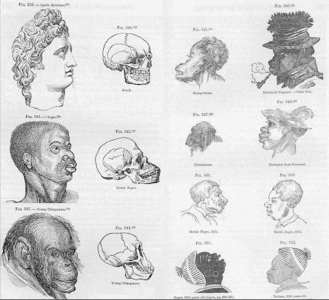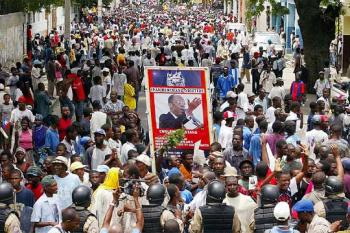Keith Mann
January 15, 2018
Trump’s latest racist rant during a horse trading session with congressional leaders from both parties about the fate of the DACA program, has been widely denounced as an escalation of his racist discourse.
Even before his latest comments, Trump demonstrated his contempt for the people of systematically underdeveloped countries by his response to Hurricanes Harvey and Maria’s devastation of the Caribbean islands, including Puerto Rico, the world’s oldest colony. These recent comments are also a noxious combination of old and new forms of racist bigotry and immigration restrictions.
 ABC Philadelphia
ABC PhiladelphiaHis distinction between countries in Africa, Haiti, and Central America on the one hand, and Norway on the other harkens back to the reactionary racist immigration policies of the 1920s and could possibly herald the beginning of a draconian overhaul of US immigration policy even beyond what we have seen from Trump and his congressional allies so far. They also remind us of the legacy of colonialism and the workings of neo-Imperialist domination and racism today.
In 1921 and 1924, congress enacted the National Origins Act which established a system of quotas all but eliminating immigration from the poorer, non-Protestant countries of Southern and Eastern Europe, whose people were then the equivalent of Haitians and others slurred by Trump. That law established US immigration policy until 1965 when the Immigration and Nationality Act replaced the quota system with family relationship and work skills requirements.
The National Origins Act reflected fear of radical socialist and labor politics, but also racist bigotry and class prejudice remarkably similar to Trump’s. It built on openly racist legislation passed in the 1880s and 1890s that sharply restricted Asian immigration. By the time the Act was passed, immigration from Northern Europe and Scandinavia had already slowed to a trickle. Since the 1880s on the other hand, large numbers of people had been coming to the US from Poland, Russia, Italy, and Greece. Most had been rural, peasant and agricultural workers and, in the case of Jews, urban workers. Initially welcomed as cheap unskilled labor for an expanding industrial economy, these rural and working-class immigrants were later targeted by nativist and conservative elites, who raised alarms about supposed racial and cultural purity. The quotas were designed to virtually eliminate immigration from those countries.
From colonial times, the ruling class had been overwhelmingly Protestant. The new immigrants were Catholic, Jewish, and various forms of Eastern Orthodox. Much of the prejudice and discrimination suffered by Irish immigrants took the form of anti-Catholic bigotry. To this religious and cultural prejudice was added notions of race, understood as a biological phenomenon.
 Excerpt from “Crania Americana” showing the supposed differences between the skulls of different races. Morton claimed similarities between the skulls of primates and African people.
Excerpt from “Crania Americana” showing the supposed differences between the skulls of different races. Morton claimed similarities between the skulls of primates and African people.This was the age of pseudo-scientific racism used to justify the imperialist colonization of Africa and Jim Crow in the US, and the new immigrants were seen as non- or semi-white racial inferiors.
Racist Pseudo-Science Behind Immigration Quotas
Figures like the British mathematician and statistician Karl Pearson embodied the connection between racist pseudo-science and immigration policy. Pearson and others advocated theories of eugenics that the Nazis later drew on for their own eugenics programs. In 1925, Pearson co-authored a paper with Margaret Moul called “The Problem of Alien Immigration to Britain illustrated by an Examination of Russian and Polish Jewish Children.” The paper referred directly to the recently established US quota system and advocated immigration policy based on carefully selected applicants who would strengthen, rather than dilute what they considered to be the superior (white) racial composition of Britain and the US. The paper documented the high rates of various diseases among Jewish immigrants, many living in slum areas, and compared them with the much lower rates for “gentiles” (non-Jews). The comparisons pointed, they held, to the racial inferiority of Eastern European Jews. Elsewhere in the paper, they fretted about the possible negative effects on national racial “hygiene” of “mixing” between white and non-white races of Asia and Africa. Such concerns, they argued, were scientific and should guide immigration policy. Pearson’s ideas have long been discredited in the scientific community, but still reappear in various forms of racist discourse and immigrant policy.
Ruling class politicians and their ideologues were also concerned about the connection between immigration, labor, and radical politics. Some immigrants from urban areas had acquired knowledge of and experience with anarchism and socialism in Europe, and some had been in unions. Many became radical labor activists and leaders in the US. All of the Haymarket martyrs, save the US-born Albert Parsons, were German—part of an earlier wave of European immigration. As far as conservatives were concerned, the Russian Revolution confirmed the connection between immigration and subversive politics. The US ruling class responded with the Palmer raids of 1920, targeting immigrant labor leaders and radicals, who were jailed and often deported. The apex of this ruling class frenzy was the frame-up and judicial murder of the Italian immigrant anarchists Sacco and Vanzetti in 1927. Earlier, Joe Hill, a Norwegian immigrant and member of the IWW, a revolutionary, multiracial labor organization, was framed for murder and executed in Utah in 1915.
A Racist for all Seasons
Over time, racist discourse in elite circles has shifted from biological arguments and political fears about left-wing radicalism, to cultural arguments, and after 9/11, fears of Islamic terrorism. (The marginalized white supremacy of the KKK remains closer to its roots in eugenics.)
Harvard professor Samuel Huntington, who served as president of the American Political Science Association, advanced a new racist agenda designed to influence US immigration policy. In his 1996 book, The Clash of Civilizations, Huntington argued that in the wake of the collapse of the USSR and the end of the cold war, communism was no longer a threat to the US. The new threat was immigration from Latin American and Muslim countries that threatened to culturally dilute the Protestant culture upon which the US was built, and should therefore be sharply restricted. Huntington’s racist thesis never disappeared from elite discourse on immigration, and Trump’s most inflammatory remarks merely recycle old tropes.
During the 2016 Presidential campaign Trump, targeted Mexicans as “rapists” and “murderers”, and then targeted Muslims as potential terrorists. His attacks on the NFL protests against racism have been widely seen as attacks aimed at black athletes and blacks in general. With his latest comments on the connection between AIDS and Haitian refugees, Trump now combines older and newer forms of racist discourse in ways reminiscent of both Pearson’s and Huntington’s ideas and recommendations.
Amnesia of Underdevelopment
In the current news cycle, the press has focused on the obvious racism of Trump’s contempt for people from countries he labels “shitholes.” Less discussed has been the degree to which imperialism has so exploited and underdeveloped those parts of the world that its peoples do in many ways live in cesspools. These cesspools are the direct result of neo-imperialist domination through the “structural adjustment” policies of the IMF and the World Bank. This innocent-sounding name refers to demands to cut social services and lay off public workers as a condition to borrow money from banks in order to pay interest on enormous loans made by those same banks decades ago, in many cases, to murderous US-supported military dictatorships.
Neo-imperialist domination of Latin America by the IMF and World Bank means shorter life expectancy, sky-high rates of infant mortality, poor and far-from-universal education, and the reproduction of women’s oppression. This imperialist domination creates the urban and rural slums where twenty-first century people live without electricity, running water, sanitation systems, or transportation, schools, health care, adequate food, and jobs outside the desperate informal economy.
 Dr. Thelisma Heber cares for a patient at the Cholera Treatment Center in Mirebalais, Haiti. Photo: Rebecca E. Rollins/Partners In Healh
Dr. Thelisma Heber cares for a patient at the Cholera Treatment Center in Mirebalais, Haiti. Photo: Rebecca E. Rollins/Partners In HealhDilapidated sanitation systems have led to the return of water-borne diseases like cholera that had been wiped out long ago. Africa’s lack of infrastructure, a legacy of colonialism, has until recently made this region undesirable even to neo-imperialist exploitation of low wage labor. The lack of health systems, a direct legacy of colonial domination, resulted in staggeringly high death rates during the AIDS epidemic, orphaning a generation of children. From the radioactive waste left at Vieques in Puerto Rico to the toxic material used on Central American highways the US has done much to create miserable living conditions throughout the global south. Yes, many people in the countries insulted by Trump live in cesspools, and those cesspools were created by the very US imperialism that Trump wants to make “great again.”
For a New Internationalism
The history of colonial and racial oppression is also that of resistance and revolt. From the Haitian revolution of the 1790s, to the African Independence movements of the 20th century, the Cuban revolution of 1959, and the revolutionary movements in the Caribbean and Central America in the 1970s and 1980s, to the Zapatista Rebellion in 1994, the peoples of the areas insulted by Trump have demonstrated an impressive capacity to struggle against imperialist oppression.
 Hundreds of thousands of Haitians demand release of political prisoners and return of President Aristide deposed by U.S.-supported coup. Photo: Reuters
Hundreds of thousands of Haitians demand release of political prisoners and return of President Aristide deposed by U.S.-supported coup. Photo: ReutersTrump’s rhetorical assault on the peoples of Haiti, Africa, and Central America, and immigrant communities from those countries could serve as a call for a new internationalism between the peoples of dominated countries and those experiencing racial and class oppression in the US.
Given the concentration of immigrants and people of color in the low wage sectors of the economy, the labor movement should denounce Trump’s comments and the policies they represent in the strongest terms and extend the hand of solidarity across borders to all workers and oppressed peoples.
More immediately we can support actions to defend immigrants that Trump has attacked, including this campaign by CISPES to maintain temporary protected status for 435,000 Haitian, El Salvadoran and Nicaraguan immigrants.
Keith Mann is a member of Solidarity in Milwaukee, Wisconsin.
